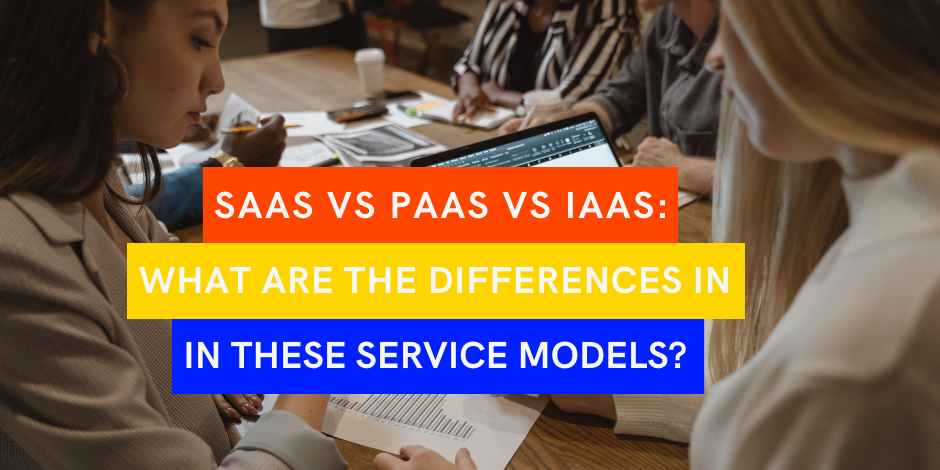SaaS vs PaaS vs IaaS: What Are the Differences in These Service Models?

Stay Informed With Our Weekly Newsletter
Receive crucial updates on the ever-evolving landscape of technology and innovation.
SaaS vs PaaS vs IaaS service models are the new face of software solution development and deployment. They are all associated with cloud computing at their core, which is based on accessing computing power, storage and cloud services without a physical infrastructure and the other expenses that come with it.
These three service models come with different features and levels of responsibility, scalability, and control. Different businesses use them to help deliver the perfect product or service to their end users. This guide will look at their critical differences, purpose, definition, and what each is best used for.
What is the difference between SaaS vs PaaS vs IaaS?

Saas (Software as a service), PaaS (Platform as a service), and IaaS (Infrastructure as a Service) are different cloud-based service models with benefits and drawbacks.
While SaaS applications provide a complete software solution overall, a virtual network, PaaS offers the tools to build and test these applications. As the IaaS comprises resources, a firm must build its cloud infrastructure, making it the core cloud computing layer.
These service models have several key differences, including responsibility, security, control, cost, and flexibility. Let’s take a detailed look into each of these differences:
Responsibility
Let’s understand the differences in responsibility with each service model. If you are employing a SaaS service, you are responsible for maintaining the overall software solution, including the underlying cloud infrastructure that includes networking and storage.
Therefore, it is essential to manage the system so the end-user can enjoy the front-end experience without worrying about any issues in the back-end of the infrastructure.
On the other hand, if you use a PaaS service model, you must maintain the technical tools required for the development process so the end-user can create an application themselves. Testing and deployment of the final application are also things that will only concern the end user. Still, it is crucial to ensure that you do not fall behind on maintaining the model on your end as the business.
With IaaS delivery models, the providing firm needs to maintain the cloud infrastructure, including the servers, networking, and storage but everything else, including the set-up and installation of different OS and applications, are the user’s concerns.
Security
There are also differences in security and how much control the providing firm has over the security of their cloud service models. Generally, IaaS and PaaS solutions offer excellent control over security, but the user is responsible for ensuring their data is secure.
On the other hand, with SaaS solutions, all security aspects of the infrastructure and the software solution are responsibilities of the business, and they need to ensure that their customers and their user data are safe from cyber-attacks.
Scalability
 Regarding scalability, IaaS solutions are at the forefront since they allow businesses to decide which cloud-based resources they wish to use and which ones they want to remove, depending on their operational requirements.
Regarding scalability, IaaS solutions are at the forefront since they allow businesses to decide which cloud-based resources they wish to use and which ones they want to remove, depending on their operational requirements.
This is not the case with SaaS and PaaS solutions. The former is scalable, but it is essential to consider how far the primary architecture can go in handling a growing customer base. As for PaaS applications, customers are responsible for building applications with the intent to scale so that there are no issues with targeting growth after the app is deployed.
Control and Flexibility
IaaS solutions are also the most flexible of the three since they are based around giving complete control to the client firm, who can then use the cloud infrastructure and modify it to fit their needs. As for PaaS and SaaS solutions, they are a lot less flexible. However, PaaS still has more flexibility since users can choose how to build applications and software solutions.
As for SaaS solutions, there is generally minimal flexibility, and the end-user can only access the software solutions as the primary business presents them.
Ease of development
If we consider ease of development with each of these solutions, IaaS is the most time-consuming. This is because it requires a lot of development and multiple cloud resources to be set up. However, PaaS and SaaS solutions are much better in this regard since most of their core infrastructure is already set up. Moreover, SaaS solutions are the easiest to set up and market since the primary firm already provides the entire software solution to begin with.
Pricing Models
Different pricing models are commonly used with each of these software solutions. While IaaS solutions are generally charged depending on how much they are used, PaaS and SaaS solutions follow the subscription pricing model, providing the user with the entire development infrastructure at that rate.
With PaaS and SaaS, the subscription cost also covers maintenance and customer support charges in its price.
What is SaaS best used for?

SaaS solutions are best used by firms who want to develop and deliver software applications remotely over the Internet so that their customers can access the solutions and engage with them. Since SaaS solutions are cloud-based service models, they can run without dependence on external software or frameworks. These solutions are designed to help businesses of all sizes in all aspects, whether they are looking to grow, save money or shift between operations.
There are several business models that SaaS solutions are perfect for, including collaboration and marketing tools.
For instance, SaaS can be used to manage team projects, provide a digital platform for file sharing, and you can even host meetings or have text-based communications on these digital tools. In addition, it is possible to plan your entire marketing campaign, deploy it and track its performance entirely with SaaS tools.
These solutions are also commonly seen in business applications like accounting applications, customer relationship management tools, or customer management systems. Other than that, SaaS solutions are found in eCommerce and education platforms. With the right SaaS solution, users can host their entire course online, open a retail store, and manage payments and customer queries efficiently.
Several popular tools that are based on SaaS solutions include Salesforce, Slack, Mailchimp, Dropbox, and Hubspot.
What is PaaS best used for?
If you want to build or use a development platform, PaaS solutions are ideal for you as they are the complete solution. You can build your ideas out using these solutions, test them and deploy them on the virtual network to be accessed by other people. With PaaS, every developer has a set of tools, databases, and frameworks that can help them focus on developing their solution without having any concerns about the cloud infrastructure the tools are built on.
Besides the web, mobile app, and software development, PaaS solutions also help build IoT applications and analyze datasets. These solutions’ monitoring features and pre-configured toolkits fast-track the entire development process. Moreover, with features like built-in scalability and multi-platform support, PaaS is a one-stop solution, making it easier for users to deploy their solutions relatively easily.
Several products are based around these cloud computing services, and some PaaS examples in cloud computing include Red Hat Openshift, IBM Cloud, Webflow, Google Cloud, AWS, OCP, and Microsoft Azure.
What is IaaS best used for?
IaaS solutions are ideal for businesses that wish to improve their scalability by accessing customizable resources that give them the flexibility and control to make better infrastructure-related decisions. These systems free the business of dependence on physical infrastructure, whether for networking, storage, or virtual machines, reducing expenses and potentially increasing revenue.
Businesses can use IaaS solutions as development and testing environments to ensure every software solution they launch is up to standard, using cloud-based storage systems, servers, and virtual machines. They are also a perfect tool for data backup and disaster recovery since it is possible to utilize them immediately in case of a cyberattack or network failure.
Since these solutions can scale resources with relative ease depending on the site traffic and customer demand, they are ideal for hosting websites, web apps, and entire e-commerce platforms. Whether you need to work through large datasets quickly or manage the data analysis workload, IaaS solutions enable you to carry out all these operations over the cloud, saving money and increasing efficiency in operations.
Some popular service providers that use IaaS include Google Computer Engine, DigitalOcean, Linode, Amazon EC2, Mircohost, and Vultr.
Conclusion
Cloud computing and its service models are perfect tools for a new startup or business trying to grow. It is interesting to note how small businesses and industry giants use these cloud service models to develop personalized solutions that appeal to their customer base and help them grow in business.
If you are willing to learn about cloud computing and get the skill set that will allow you to work with all these cloud service models, you need to start by developing your knowledge about Data science and AI. To learn more about how to start your learning journey with no hiccups or tiresome pre-planning, schedule a career consultation with one of our career experts now and get the right plan immediately!

